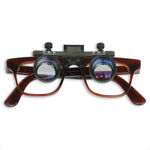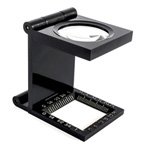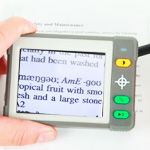A significant visual impairment that cannot be corrected fully with glasses, contact lenses, medication or eye surgery is termed as low vision. It is caused by severe eye disease, in which visual acuity in the better eye is 20/70 or less, or where there is a significant loss of visual field (constriction to 20 degrees or less, termed tunnel vision).
Visual acuity of that a person with 20/70 vision who is 20 feet from an eye chart sees what a person with unimpaired (or 20/20) vision can see from 70 feet away. Low vision can impact people of all ages, but it is associated primarily with adults over the age of 60.
The World Health Organisation defines low vision as:
A person with low vision is one who has impairment of visual functioning even after treatment and/or standard refractive correction, and has a visual acuity of less than 6/18 to light perception, or a visual field of less than ten degrees from the point of fixation, but who uses, or is potentially able to use, vision for planning and/ or execution of a task.
Causes
Causes and typical patterns of low vision which cannot be corrected include:
- Blurred or partially obscured central vision: Macular degeneration (both, age-related, and hereditary)
- Blind spots, blurriness and visual distortions: Diabetic retinopathy
- Poor peripheral vision, or tunnel vision: Glaucoma
- Poor peripheral vision, and inability to see in the dark: Retinitis pigmentosa
- Eye injuries
- Poor central vision which may progress to no light perception: Optic neuropathies which may be inherited or acquired (toxic)
In real life situations, vision loss that cannot be corrected and that which interferes with your daily activities may be termed low vision. It is better defined regarding function, rather than test results.
In case you find it difficult to see or struggle with day to day tasks because of poor vision, you must seek a comprehensive eye examination by visiting us.
More often than not, your vision can be corrected using eyeglasses, contact lens or even surgery, as in the case of cataracts. If not, your doctor will conduct special tests to determine the cause, type, and severity of vision loss. After the initial assessment, he or she will help you take the next steps toward coping with your life circumstances.
Once the visual loss has been ascertained, the low vision specialist can prescribe appropriate low vision aids, best suited for your condition, and teach you how to use them. There are several low vision aids and devices to help you cope with your day to day living. The most commonly prescribed ones include lighted handheld magnifiers, digital desktop magnifiers, and bioptic telescopes. Newer software that simplifies computer use with magnification and text-to-speech features are also available and can be customised to your specific needs.
Low vision specialists also recommend non-optical adaptive devices, such as large-font books and magazines, audio books, special light fixtures and signature guides for signing checks and documents.
Low Vision Aids
The most commonly prescribed low vision aids include:
Magnifying Spectacles

Stand Magnifiers

Telescopes

Video Magnifiers

Low Vision Techniques
These adaptations, called low vision techniques help with everyday tasks.
- Increase the lighting in your house: Replace light bulbs with bulbs of higher wattage, and make all nooks and crannies are adequately illuminated to prevent falls and improve visibility.
- Reduce glare: Adjust light fixtures to minimise Shield your eyes from dazzle by wearing sunglasses and a wide-brimmed hat or a dupatta/ stole wrapped around your face shielding your eyes.
- Use heavy, bold felt tip markers for writing and shopping lists: Use a whiteboard to mark essential dates and calendars.
- Special low vision devices: Watches, remotes, and thermostats that “talk back” are also readily available, and affordable.
In case of children, special schools and occupational therapists may be contacted to help them learn to be self-reliant. A supportive home and work/school environment help the patient cope better with low vision.
Most important of all is to maintain a positive and cheerful attitude to life. So many diseases that were considered incurable now can be successfully treated. Scientists all over the world are relentlessly working on conditions that cause permanent vision loss and damage, and we can all hope for an early breakthrough.
Our Team
Meet our specialists who will examine, treat and guide you if you have low vision. You have no reason to worry as you will be in trusted and safe hands at Eye7 Chaudhary Eye Centre.


